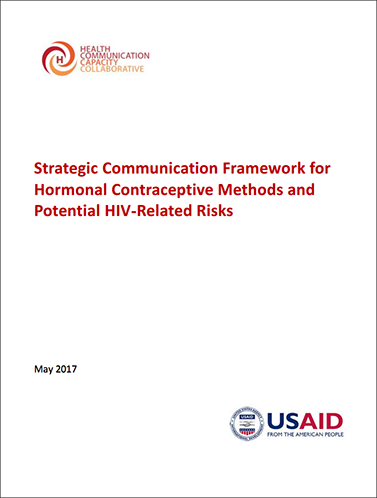Updates to HC3’s Strategic Communication Framework for Hormonal Contraceptive Methods and Potential HIV Related Risks
In March of this year the World Health Organization (WHO) released a new Guidance Statement regarding hormonal contraceptive eligibility for women at high risk of HIV as an update to the 2015 Medical Eligibility Criteria for Contraceptive Use (MEC). This new guidance announces one important change to the MEC: changing the recommendation for progestogen-only injectables among women at high risk for HIV from a category 1, with no restrictions on use, to a category 2, such that the advantages of using the method generally outweigh theoretical or proven risks.
 Based on this change to the MEC, the Health Communication Capacity Collaborative (HC3) has updated the Strategic Communication Framework for Hormonal Contraceptive Methods and Potential HIV Related Risks to include this new information and provide updated messages. This Framework was first published in January of 2016 after pilot testing in Malawi and Swaziland. The Framework provides guidance for countries to develop a communication strategy focused on the possible relationship between HIV acquisition and hormonal contraceptives, specifically progestogen-only injectables.
Based on this change to the MEC, the Health Communication Capacity Collaborative (HC3) has updated the Strategic Communication Framework for Hormonal Contraceptive Methods and Potential HIV Related Risks to include this new information and provide updated messages. This Framework was first published in January of 2016 after pilot testing in Malawi and Swaziland. The Framework provides guidance for countries to develop a communication strategy focused on the possible relationship between HIV acquisition and hormonal contraceptives, specifically progestogen-only injectables.
The Framework walks users through the process of developing a communication strategy step by step, taking into account the country’s current contraceptive use, HIV prevalence and other local context. The four steps of strategy development outlined in the framework are:
- Understanding the Evidence Base – what information is currently available on the relationship between different hormonal contraceptive methods and HIV;
- Contextualizing the Evidence – what does this information mean for the specific country based on the current sexual and reproductive health programs in place and epidemiological information available;
- Adapting the Strategic Communication Framework – taking the framework provided and making sure it is relevant to the country through crafting a situational analysis, audience segmentation, strategic design and monitoring and evaluation; and
- Preparing for implementation.
HC3 has provided possible key audiences in this Framework, including five primary audiences and three influencing audiences. The primary audiences are:
- Sexually active women of unknown status or who are HIV negative
- Sexually active women living with HIV
- Health system managers
- Clinical service providers
- Non-clinical service providers
And the three influencing audiences are:
- Male partners
- Civil society stakeholders
- Media/journalists
Countries can adapt the key messages provided under each audience for their specific context and refer to the example activities given to pursue dissemination of the messages.
By updating this Framework with the most current WHO guidance, HC3 hopes to continue to be a useful tool to ensure women are educated about any possible risk associated with progestogen-only injectables and are able to make an informed choice as to which method of hormonal contraception they choose to use.







Leave a Reply
Want to join the discussion?Feel free to contribute!